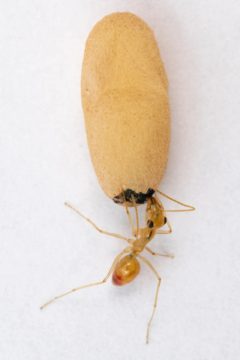Joshua Sokol in The New York Times:
 Orli Snir, a biologist at the Rockefeller University in New York, couldn’t keep her ants alive. She had plucked pupae from a colony of clonal raider ants, where the sesame seed-size offspring that looked like puffed rice cereal were being fussed over by both younger larvae and older adult ants. Then she had isolated each pupa into a tiny, dry test tube. And every time, they drowned. More specifically, each pupa was leaking so much watery, golden-tinted fluid it was struggling to breathe. But they lived when Dr. Snir whisked the fluid away with a capillary tube. Her humble observation led down a strange path of experiments toward a bizarre but inescapable conclusion: This mysterious ant goo functions a lot like milk.
Orli Snir, a biologist at the Rockefeller University in New York, couldn’t keep her ants alive. She had plucked pupae from a colony of clonal raider ants, where the sesame seed-size offspring that looked like puffed rice cereal were being fussed over by both younger larvae and older adult ants. Then she had isolated each pupa into a tiny, dry test tube. And every time, they drowned. More specifically, each pupa was leaking so much watery, golden-tinted fluid it was struggling to breathe. But they lived when Dr. Snir whisked the fluid away with a capillary tube. Her humble observation led down a strange path of experiments toward a bizarre but inescapable conclusion: This mysterious ant goo functions a lot like milk.
Not just one ant species uses this milk, either. Perhaps all ants do, according to a paper led by Dr. Snir that was published Wednesday in the journal Nature. It adds ants among other unexpected creatures like pigeons, spiders and beetles that feed each other milk-like fluids. And much like milk in mammals, it knits together ants of different generations — and the larger ant society, too. After first noticing the strange secretions, Dr. Snir scanned through the scientific literature and it seemed that her ant pupae were oozing something that was mostly unknown to science. She shared what she had found with her co-author, Daniel Kronauer, who leads a research group on ant evolution at Rockefeller. “My first thought was, ‘This is crazy,’” he said.
More here.
